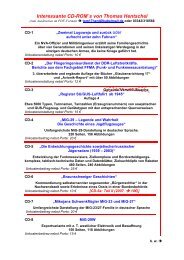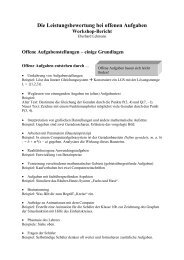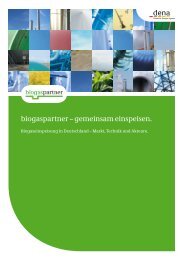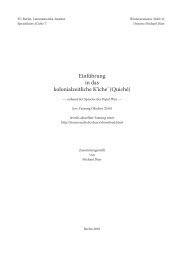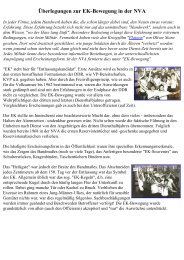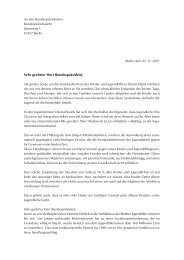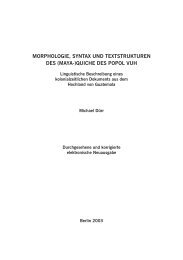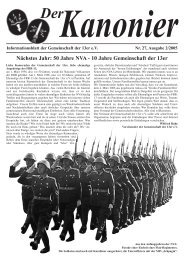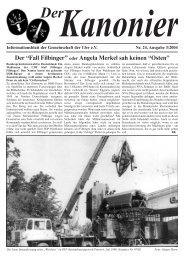SHADOW BOXING: INDONESIAN WRITERS ... - home . snafu . de
SHADOW BOXING: INDONESIAN WRITERS ... - home . snafu . de
SHADOW BOXING: INDONESIAN WRITERS ... - home . snafu . de
Create successful ePaper yourself
Turn your PDF publications into a flip-book with our unique Google optimized e-Paper software.
182 Marshall Clark<br />
particular the well-documented economic and political events of late 1997 and 1998.<br />
In effect, Pipit, like one of his fictional dukun, claims a power that Suharto, even as<br />
self-proclaimed Bapak Pembangunan (Father of Construction), lacked—the power to<br />
"construct" the future. The final text to be discussed, a short story by Martin<br />
Suhartono, reveals precisely what the future held for Suharto: his enforced<br />
"abdication" from the presi<strong>de</strong>ncy, an act otherwise known as lengser keprabon.<br />
Revisiting Lengser Keprabon: Martin Suhartono's "Lengsernya Rahwana"<br />
In a manner highly reminiscent of Pipit's insolent parody of Suharto, Martin<br />
Suhartono's "Lengsernya Rahwana" (The Abdication of Rahwana), published in July<br />
1998, is another highly personalized attack on the legacies of Suharto's authoritarian<br />
rule. 101 As with Pipit's Baratayuda di Negeri Antah Berantah, the importance of Martin's<br />
story lies not so much in its artistic or literary merit, but rather in the way in which it<br />
displays the symptoms of the times and the changing society in which it appears. The<br />
story's title is the most obvious clue that this tale is concerned, at different levels, with<br />
representing something of the truth and reality of late New Or<strong>de</strong>r Indonesia. Of course,<br />
"Lengsernya Rahwana" is easily recognized as a play on Suharto's much-discussed<br />
intention to "lengser keprabon, ma<strong>de</strong>g pandhita," or "abdicate" the presi<strong>de</strong>ncy at the<br />
appropriate time. 102<br />
Using a flashback technique popularized by a number of Java's more progressive<br />
dalang, Martin's story opens with the <strong>de</strong>ath of Rahwana, and then through a shift in<br />
time-frame it recounts the birth of Rahwana and the series of misadventures leading to<br />
his <strong>de</strong>ath. Yet the story is by no means linear, and it often digresses into streams of<br />
highly politicized wayang exegesis and thinly-veiled allusions to Suharto and his<br />
regime. Consi<strong>de</strong>r the tongue-in-cheek combination of wayang discourse and references<br />
to Suharto and his governance in the story's dramatic opening passage:<br />
The ground shook, the sky thun<strong>de</strong>red, the mountains shud<strong>de</strong>red, and the sea<br />
churned when Rahwana died. The entire cosmos was moved when Rahwana's ten<br />
heads were chopped off one by one and hit the ground. Nature was moved not<br />
because she was sad, of course. If she could, she would have sung out aloud<br />
Sorak-Sorak Bergembira [Shouts of Happiness], just like the majority of the people<br />
of the Kingdom of Nusantara when The Lord was <strong>de</strong>throned by a landsli<strong>de</strong>. The<br />
difference between The Lord and Rahwana was that Rahwana had the Aji<br />
Pancasona, whereas The Lord had the Aji Pancasila. 103<br />
Stylistically, "Lengsernya Rahwana" is dominated by the wayang medium, and in<br />
particular the language and narrative techniques of wayang shadow puppeteers.<br />
Common wayang terms and expressions are evoked and manipulated as a means of<br />
101 Martin Suhartono, "Lengsernya Rahwana/' Basis 47,7-8 (July-August 1998): 63-68.<br />
102 See Benedict An<strong>de</strong>rson, "A Javanese King Talks of his End," Insi<strong>de</strong> Indonesia 54 (April-June 1998): 16-<br />
17; and Franz Magnis-Suseno, "Langsir Keprabon."<br />
103 "Bumi gonjang-ganjing, langit kerlap-kerlip, gunung morat-marit, dan laut mbolak-mbalik ketika Rahwana<br />
binasa. Seluruh alam semesta bergolak sewaktu sepuluh kepala Rahwana copot satu per satu menimpa<br />
bumi. Alam bergejolak bukan karena sedih, tentu saja. Seandainya bisa, alam raya akan bernyanyi Sorak-<br />
Sorak Bergembira, sama seperti mayoritas tunggal warga kerajaan daripada Nusantara sewaktu Sang Prabu<br />
longsor keprabon. Bedanya, Rahwana mengandalkan Aji Pancasona, sedangkan sang Prabu Aji Pancasila."<br />
Martin Suhartono, "Lengsernya Rahwana," p. 63.


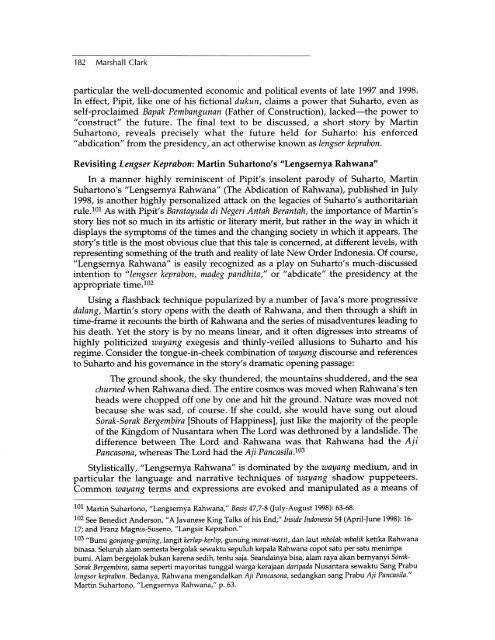
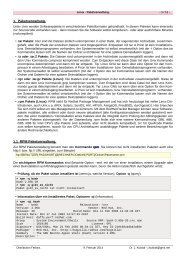
![Parameterdarstellungen [ x(t), y(t) ] Eberhard ... - home . snafu . de](https://img.yumpu.com/22517728/1/184x260/parameterdarstellungen-xt-yt-eberhard-home-snafu-de.jpg?quality=85)
